Study on the Mechanical Performance, Durability, and Microscopic Mechanism of Cement Mortar Modified by a Composite of Graphene Oxide and Nano-Calcium Carbonate
Abstract
:1. Introduction
2. Materials and Methods
2.1. Experimental Materials
2.2. Experimental Methods
- Mechanical performance testing
- Water absorption test
- Water penetration resistance test
- Chloride ion penetration resistance test
- Sulfate corrosion resistance test
- X-ray diffraction (XRD) phase analysis
- Scanning Electron Microscope (SEM) microstructure analysis
- Mercury Intrusion Porosimetry (MIP) pore size distribution
3. Experimental Results and Discussion
3.1. Mechanical Properties
3.2. Durability Performance
3.2.1. Water Absorption Test
3.2.2. Water Penetration Resistance Test
3.2.3. Chloride Ion Penetration Resistance Test
3.2.4. Sulfate Corrosion Resistance Test
3.3. Microscopic Characterization
3.3.1. XRD Phase Analysis
3.3.2. SEM Microstructure Analysis
3.3.3. MIP Pore Size Distribution
4. Conclusions
- (1)
- The optimal mixing ratio for improving the mechanical and durability properties of the mortar was 0.02 wt% graphene oxide and 1 wt% nano-calcium carbonate. Compared with the Ref group, the 28 days of flexural strength and compressive strength of the GO-NC modified mortar increased by 12.9% and 12.4%, respectively. In all of the durability tests, the addition of both GO and NC improved the water permeability and ion penetration resistance of the mortar due to their pore-filling effect. When the two materials were combined, due to their different particle size distribution, different filling effects were observed, resulting in the most significant improvement in the mechanical and durability properties of the mortar by GO-NC.
- (2)
- XRD analysis showed that the nucleation effect of GO and NC caused Ca+ and OH− in the hydration products to be quickly absorbed. However, GO only changed the quantity of hydration products. The reason for the appearance of new hydration products was that NC reacted with tricalcium aluminate (C3A) to generate new hydration products, i.e., calcium aluminate hydrate;
- (3)
- Combining SEM analysis and MIP pore size distribution results, both graphene oxide (GO) and nano-calcium carbonate (NC) promote hydration, improve the arrangement of hydration products, and further enhance their pore-filling effect. This leads to denser hydration products, ultimately enhancing the mechanical and durability properties of the overall structure. The pore-filling effect of GO-NC reduced the percentage of harmful pores from 40.2% to 29.9%, increasing the proportion of harmless and less harmful pores. The synergistic effect of GO and NC improves the uniformity of pore size distribution in the mortar across the entire range, leading to a stronger connection between the hydration products and the aggregate interface transition zone (ITZ), resulting in a more uniform microstructure of the ITZ;
- (4)
- In most studies, the content of graphene oxide was typically 0.03 wt% to 0.08 wt% [9,16]. In this paper, the optimal content of graphene oxide was reduced to 0.02 wt%, further lowering the cost threshold of graphene oxide in construction. The experimental results promoted the application of nano-calcium carbonate and expanded the application fields of graphene oxide and nano-calcium carbonate. We hope it will be helpful for the research of other researchers.
Author Contributions
Funding
Data Availability Statement
Acknowledgments
Conflicts of Interest
Appendix A
References
- Makul, N. Modern sustainable cement and concrete composites: Review of current status, challenges and guidelines. Sustain. Mater. Technol. 2020, 25, e00155. [Google Scholar] [CrossRef]
- Zeng, H.; Qu, S.; Tian, Y.; Hu, Y.; Li, Y. Recent progress on graphene oxide for next-generation concrete: Characterizations, applications and challenges. J. Build. Eng. 2023, 69, 106192. [Google Scholar] [CrossRef]
- Raj, R.S.; Arulraj, G.P.; Anand, N.; Kanagaraj, B.; Lubloy, E.; Naser, M. Nanomaterials in geopolymer composites: A review. Dev. Built Environ. 2023, 13, 100114. [Google Scholar] [CrossRef]
- Alvi, I.H.; Li, Q.; Hou, Y.; Onyekwena, C.C.; Zhang, M.; Ghaffar, A. A critical review of cement composites containing recycled aggregates with graphene oxide nanomaterials. J. Build. Eng. 2023, 69, 105989. [Google Scholar] [CrossRef]
- de Souza, F.B.; Yao, X.; Lin, J.; Naseem, Z.; Tang, Z.Q.; Hu, Y.; Gao, W.; Sagoe-Crentsil, K.; Duan, W. Effective strategies to realize high-performance graphene-reinforced cement composites. Constr. Build. Mater. 2022, 324, 126636. [Google Scholar] [CrossRef]
- Alateah, A.H. Graphene concrete: Recent advances in production methods, performance properties, environmental impact and economic viability. Case Stud. Constr. Mater. 2023, 19, e02653. [Google Scholar] [CrossRef]
- Salami, B.A.; Mukhtar, F.; Ganiyu, S.A.; Adekunle, S.; Saleh, T.A. Graphene-based concrete: Synthesis strategies and reinforcement mechanisms in graphene-based cementitious composites (Part 1). Constr. Build. Mater. 2023, 396, 132296. [Google Scholar] [CrossRef]
- Abdalla, J.A.; Hawileh, R.A.; Bahurudeen, A.; Jittin; Kabeer, K.S.A.; Thomas, B. Influence of synthesized nanomaterials in the strength and durability of cementitious composites. Case Stud. Constr. Mater. 2023, 18, e02197. [Google Scholar] [CrossRef]
- Fonseka, I.; Mohotti, D.; Wijesooriya, K.; Lee, C.-K.; Mendis, P. Influence of Graphene oxide on abrasion resistance and strength of concrete. Constr. Build. Mater. 2023, 404, 133280. [Google Scholar] [CrossRef]
- Lu, D.; Shi, X.M.; Zhong, J. Interfacial nano-engineering by graphene oxide to enable better utilization of silica fume in cementitious composite. J. Clean. Prod. 2022, 354, 131381. [Google Scholar] [CrossRef]
- Lu, D.; Shi, X.M.; Zhong, J. Nano-engineering the interfacial transition zone in cement composites with graphene oxide. Constr. Build. Mater. 2023, 356, 129284. [Google Scholar] [CrossRef]
- Luo, J.; Zhou, C.; Li, W.; Chen, S.; Korayem, A.H.; Duan, W. Using graphene oxide to improve physical property and control ASR expansion of cement mortar. Constr. Build. Mater. 2021, 307, 125006. [Google Scholar] [CrossRef]
- Yu, L.B.; Bai, S.; Guan, X.C. Graphene oxide-silica nanocomposites reinforced mortars: Mechanical properties, permeability and microstructure. Constr. Build. Mater. 2022, 344, 128290. [Google Scholar] [CrossRef]
- Liu, C.; Huang, X.; Wu, Y.-Y.; Deng, X.; Zheng, Z. The effect of graphene oxide on the mechanical properties, impermeability and corrosion resistance of cement mortar containing mineral admixtures. Constr. Build. Mater. 2021, 288, 123059. [Google Scholar] [CrossRef]
- Tatineni, Y.S.; Putta, J. Enhanced Strength, Durability, and Microstructural Attributes of Graphene Oxide-Modified Ultrafine Slag Cement Mortar. Buildings 2022, 12, 2199. [Google Scholar] [CrossRef]
- Kaur, R.; Bhatrola, K.; Kumar, A.; Kaur, J.; Suhag, S.; Maurya, S.K.; Kothiyal, N. Durability of cementitious mortar: Incorporation of highly dispersed superplasticizer modified graphene oxide in fly ash blended mortar. J. Build. Eng. 2023, 80, 107888. [Google Scholar] [CrossRef]
- Cheng, X.; Zhou, J.; Luo, L.; Shen, S.; Zhang, J. Boosting Bulk Oxygen Transport with Accessible Electrode Nanostructure in Low Pt Loading PEMFCs. Small 2024, 20, 2308563. [Google Scholar] [CrossRef] [PubMed]
- Fu, Q.; Zhang, Z.; Zhao, X.; Xu, W.; Niu, D. Effect of nano calcium carbonate on hydration characteristics and microstructure of cement-based materials: A review. J. Build. Eng. 2022, 50, 104220. [Google Scholar] [CrossRef]
- Liu, X.; Chen, L.; Liu, A.; Wang, X. Effect of Nano-CaCO3 on Properties of Cement Paste. Energy Procedia 2012, 16, 991–996. [Google Scholar] [CrossRef]
- Shaikh, F.U.A.; Supit, S.W.M. Mechanical and durability properties of high volume fly ash (HVFA) concrete containing calcium carbonate (CaCO3) nanoparticles. Constr. Build. Mater. 2014, 70, 309–321. [Google Scholar] [CrossRef]
- Shen, D.; Kang, J.; Shao, H.; Liu, C.; Li, M.; Chen, X. Cracking failure behavior of high strength concrete containing nano-CaCO3 at early age. Cem. Concr. Compos. 2023, 139, 104996. [Google Scholar] [CrossRef]
- Poudyal, L.; Adhikari, K.; Won, M. Nano Calcium Carbonate (CaCO3) as a Reliable, Durable, and Environment-Friendly Alternative to Diminishing Fly Ash. Materials 2021, 14, 3729. [Google Scholar] [CrossRef] [PubMed]
- Poudyal, L.; Adhikari, K.; Won, M. Mechanical and Durability Properties of Portland Limestone Cement (PLC) Incorporated with Nano Calcium Carbonate (CaCO3). Materials 2021, 14, 905. [Google Scholar] [CrossRef] [PubMed]
- Meng, T.; Ying, K.; Yang, X.; Hong, Y. Comparative study on mechanisms for improving mechanical properties and microstructure of cement paste modified by different types of nanomaterials. Nanotechnol. Rev. 2021, 10, m370–m384. [Google Scholar] [CrossRef]
- Han, Y.; Yang, B.; Meng, L.-Y.; Oh, S.; Kim, T.; Wang, X.-Y. Innovative use of wet carbon conversion in alkali-activated slag: Improved microstructures and mechanical characteristics. Constr. Build. Mater. 2024, 411, 134487. [Google Scholar] [CrossRef]
- Feng, J.H.; Yang, F.; Qian, S.Z. Improving the bond between polypropylene fiber and cement matrix by nano calcium carbonate modification. Constr. Build. Mater. 2021, 269, 121249. [Google Scholar] [CrossRef]
- Hosan, A.; Shaikh, F.U.A. Compressive strength development and durability properties of high volume slag and slag-fly ash blended concretes containing nano-CaCO3. J. Mater. Res. Technol. 2021, 10, 1310–1322. [Google Scholar] [CrossRef]
- Chen, X.; Ai, Y.; Wu, Q.; Cheng, S.; Wei, Y.; Xu, X.; Fan, T. Potential use of nano calcium carbonate in polypropylene fiber reinforced recycled aggregate concrete: Microstructures and properties evaluation. Constr. Build. Mater. 2023, 400, 132871. [Google Scholar] [CrossRef]
- Li, J.Q.; Zheng, Q. The first experimental evidence for improved nanomechanical properties of calcium silicate hydrate by polycarboxylate ether and graphene oxide. Cem. Concr. Res. 2022, 156, 106787. [Google Scholar] [CrossRef]
- GBT 17671-2021; Test Method for Strength of Cement Mortar (ISO Method). Standards Press of China: Beijing, China, 2021; pp. 2–18.
- JGJ/T 70-2009; Standard for Test Method of Basic Properties of Construction Mortar. China Architecture & Building Press: Beijing, China, 2009; pp. 20–21.
- Qureshi, T.S.; Panesar, D.K. Nano reinforced cement paste composite with functionalized graphene and pristine graphene nanoplatelets. Compos. Part B 2020, 197, 108063. [Google Scholar] [CrossRef]
- Wu, Z.; Khayat, K.H.; Shi, C.; Tutikian, B.F.; Chen, Q. Mechanisms underlying the strength enhancement of UHPC modified with nano-SiO2 and nano-CaCO3. Cem. Concr. Compos. 2021, 119, 03992. [Google Scholar] [CrossRef]
- Hulagabali, M.M.; Vesmawala, G.R.; Patil, Y.D. Synthesis, characterization, and application of graphene oxide and reduced graphene oxide and its influence on rheology, microstructure, and mechanical strength of cement paste. J. Build. Eng. 2023, 71, 106586. [Google Scholar] [CrossRef]
- Wang, L.; Zhang, S.; Zheng, D.; Yang, H.; Cui, H.; Tang, W.; Li, D. Effect of Graphene Oxide (GO) on the Morphology and Microstructure of Cement Hydration Products. Nanomaterials 2017, 7, 429. [Google Scholar] [CrossRef] [PubMed]
- Naseem, Z.; Shamsaei, E.; Sagoe-Crentsil, K.; Duan, W. Microstructural and polymer film interaction mechanisms: Insights of GO-reinforced polymer-modified cement composites. J. Build. Eng. 2023, 80, 107962. [Google Scholar] [CrossRef]
- Zhang, R.; Long, Z.; Long, G.; Wang, J.; Wang, X.; Zhang, X.; Jiang, Y. Mechanism of graphene oxide concrete macro-micro properties evolution under large temperature difference freeze-thaw action. Constr. Build. Mater. 2024, 415, 135019. [Google Scholar] [CrossRef]
- Chen, Q.; Yan, G.; Zhuang, X.; Pain, A. Dynamic characteristics and microstructural study of nano calcium carbonate modified cemented soil under different salt water solutions. Transp. Geotech. 2022, 32, 100700. [Google Scholar] [CrossRef]
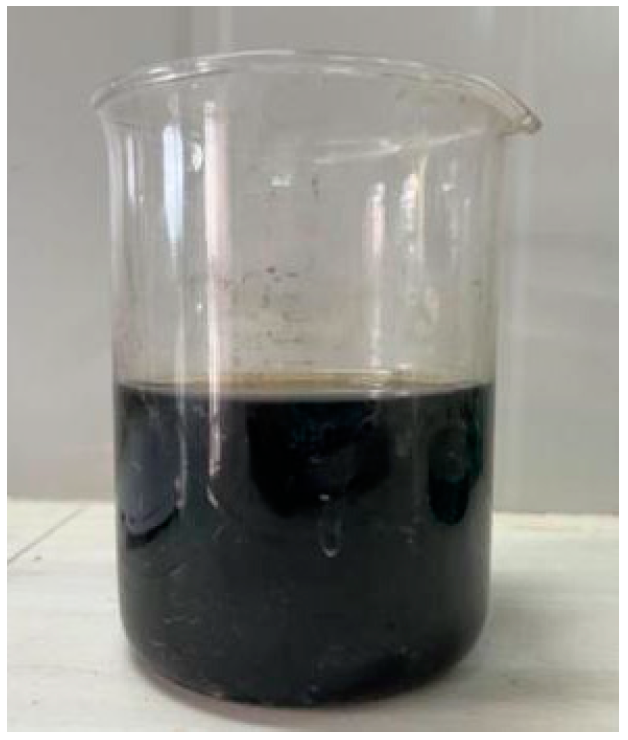
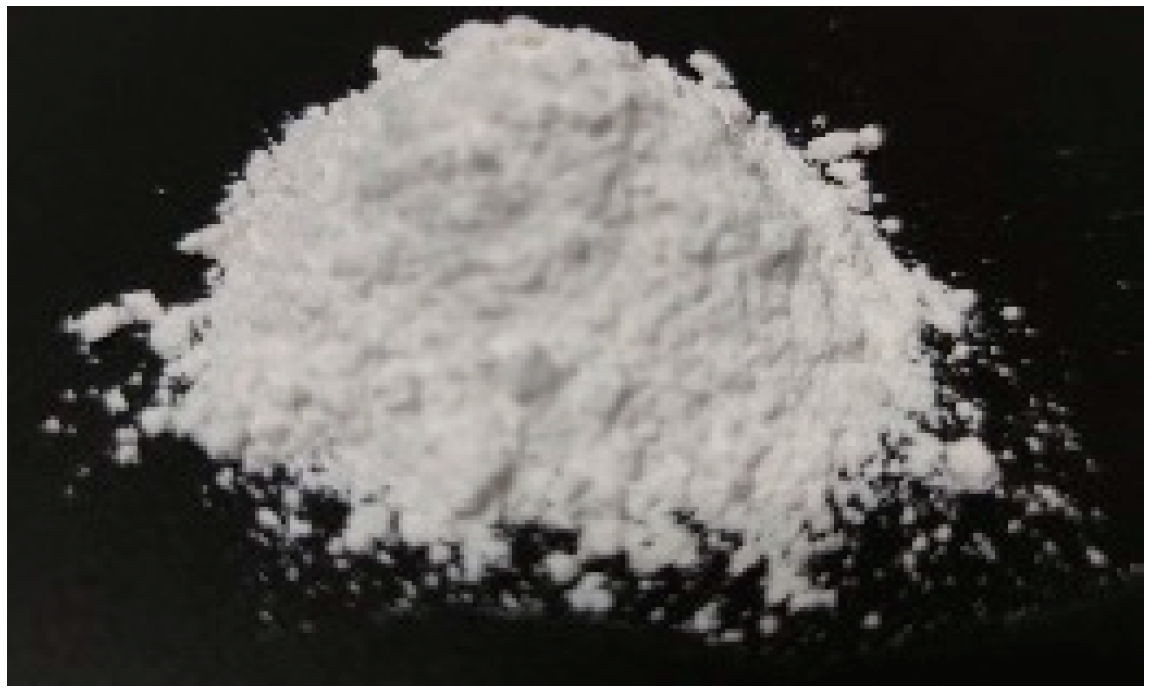
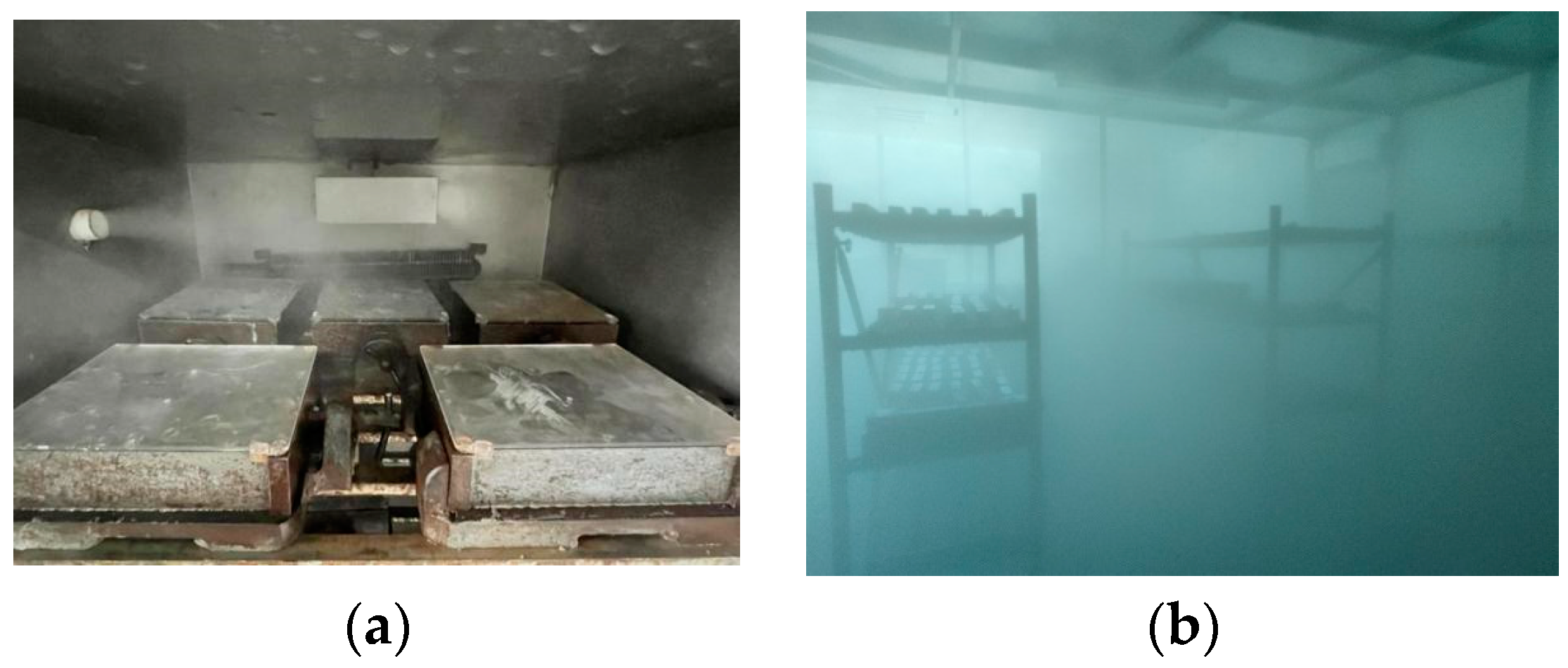
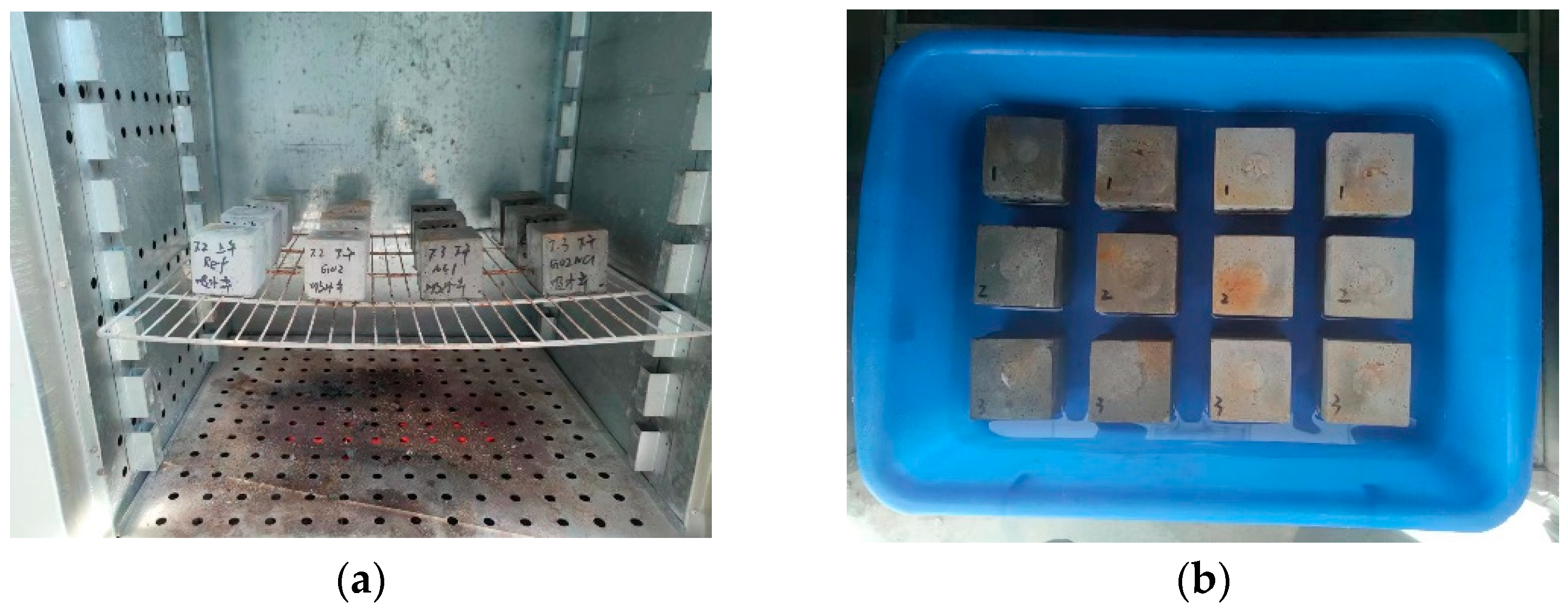
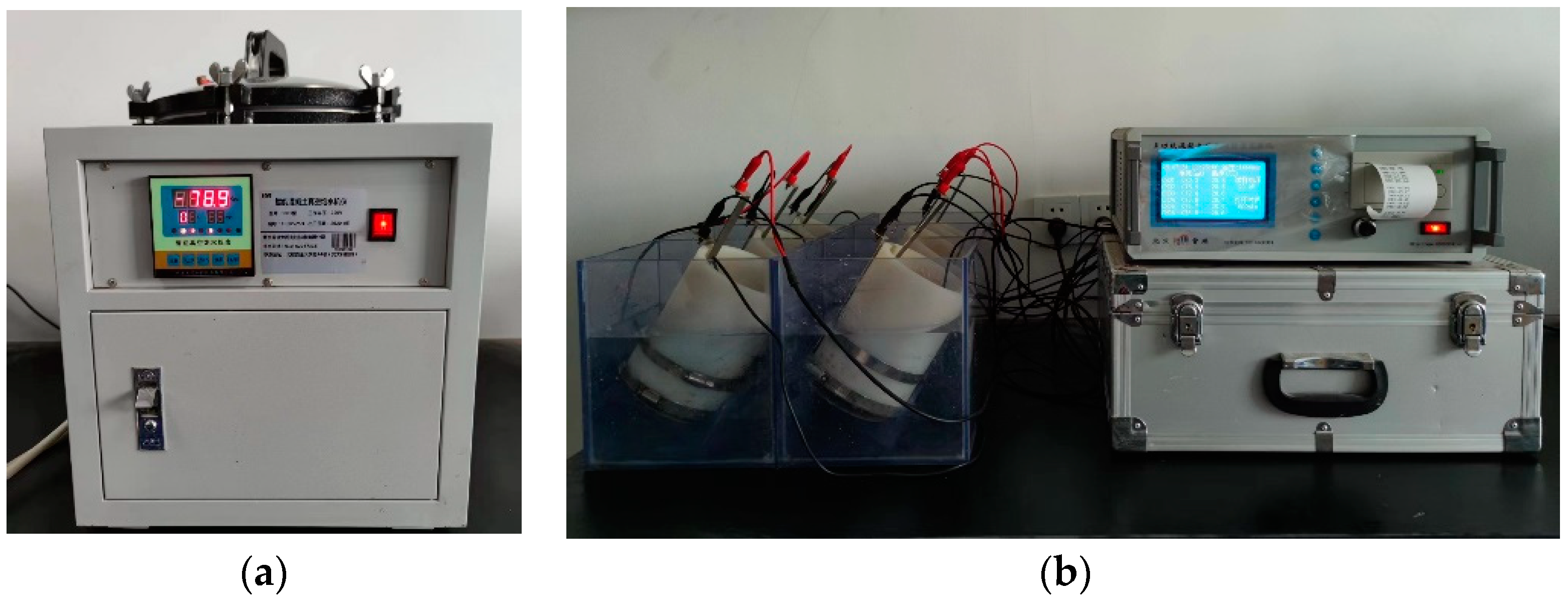
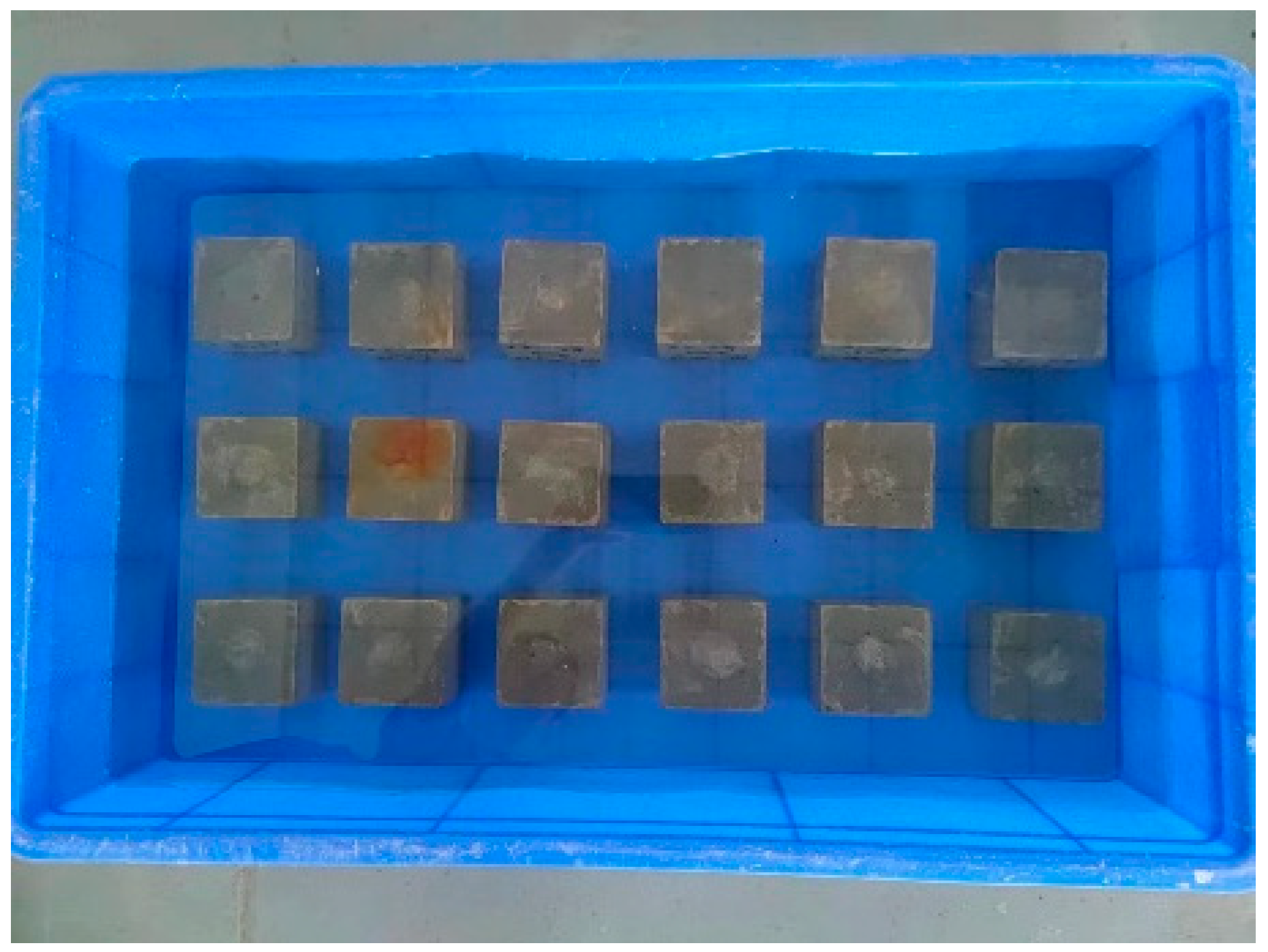






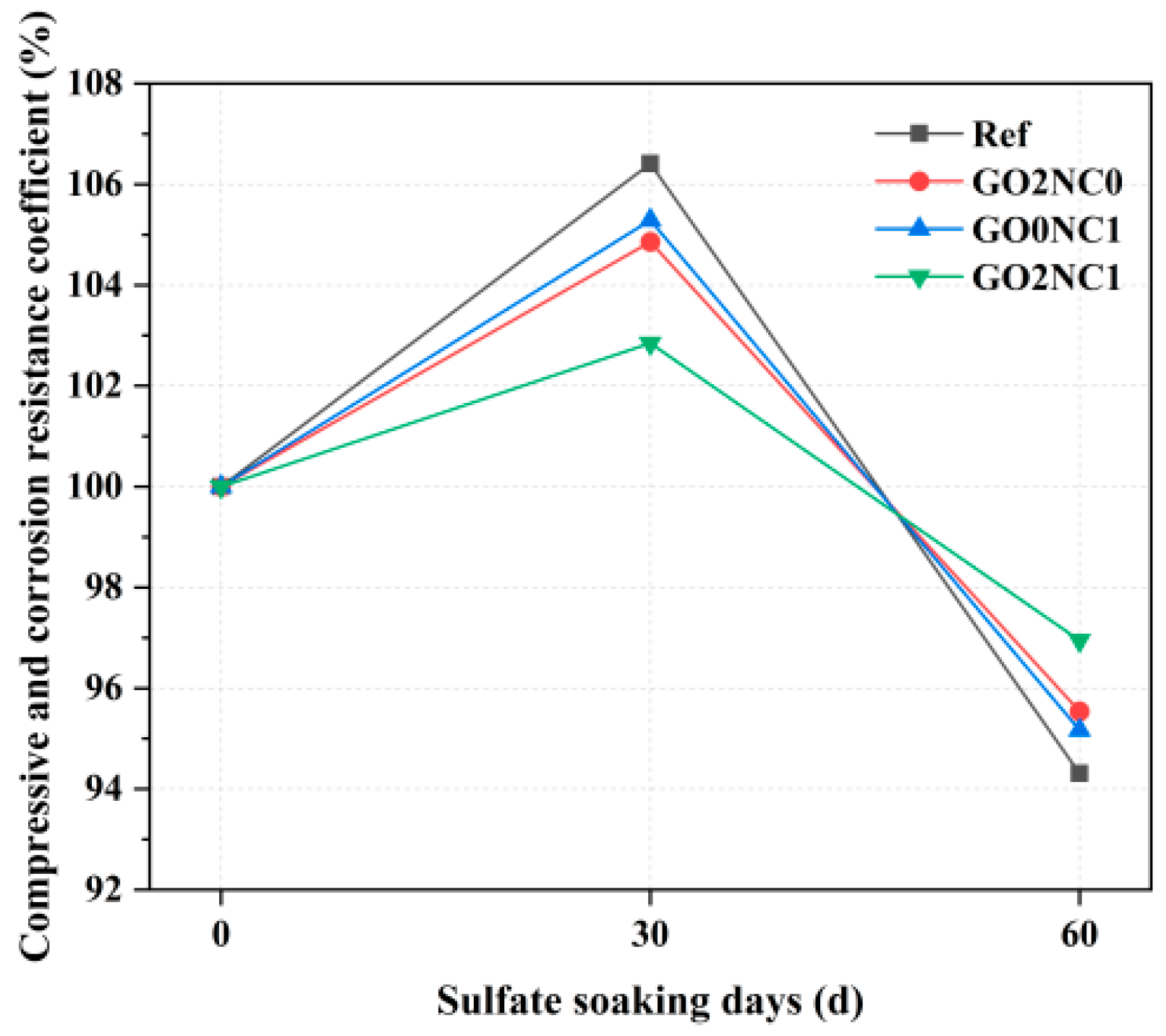


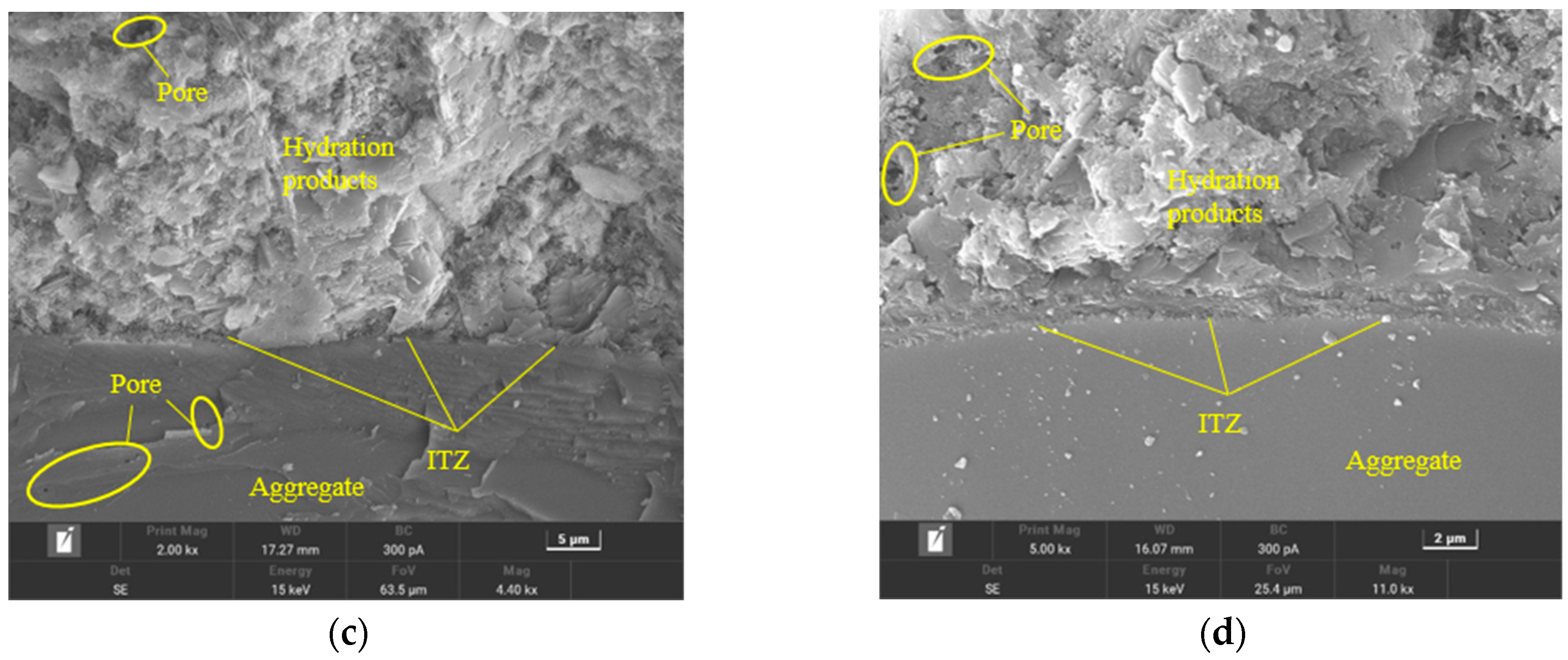
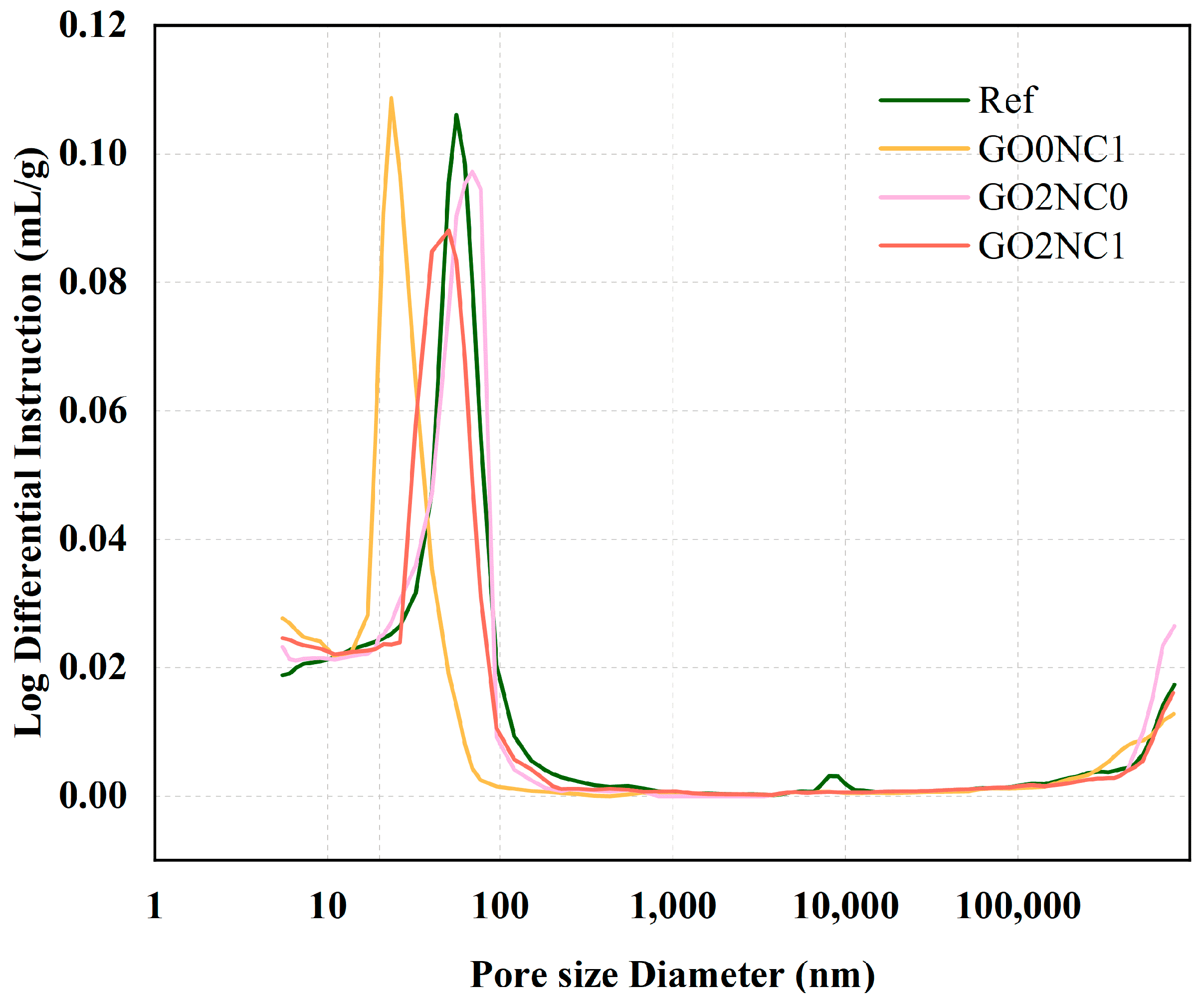
| Appearance | Solid Content (%) | Viscosity (mPa·s) | Particle Size (um) | PH | Carbon Content (%) |
|---|---|---|---|---|---|
| Brownish black | 0.96 | 3527 | 14.08 | 1.94 | 44.74 |
| Appearance | Particle Size (μm) | Specific Surface Area (m²/g) | PH | CaCO3 (%) | MgO (%) | SiO2 (%) | Al2O3 (%) | Fe2O3 (%) |
|---|---|---|---|---|---|---|---|---|
| White powder | 40 | 40 | 8.5~9 | ≥98% | ≤0.5% | ≤0.1% | ≤0.1% | ≤0.1% |
| Specific Surface Area (m²/g) | Loss on Ignition (%) | Initial Setting Time (min) | Final Setting Time (min) | MgO (%) | SO3 (%) | Cl− (%) |
|---|---|---|---|---|---|---|
| 385 | 4.11 | 210 | 276 | 2.6 | 2.56 | 0.042 |
| Apparent Density (kg/m3) | Bulk Density (kg/m3) | Clay Lump Content (%) | Ruggedness (%) | Crush Index (%) | Cl− (%) | Water Absorption (%) | |
|---|---|---|---|---|---|---|---|
| Test value | 2757 | 1457 | 0.2 | 3 | 19 | 0.001 | 1.7 |
| Appearance | Packing Density (g/cm³) | PH | Cl− (%) | Na2O (%) | Water-Reducing Rate (%) |
|---|---|---|---|---|---|
| White powder | 0.6 ± 0.1 | 10.5 ± 0.5 | ≤0.1 | ≤2 | 30 |
| Number | GO (wt%) | NC (wt%) | Cement (g) | Sand (g) | Water (g) | Water Reducer (g) |
|---|---|---|---|---|---|---|
| GO0NC0 | 0 | 0 | 450 | 1350 | 225 | 0.12 |
| GO0NC0.5 | 0.5 | 447.75 | ||||
| GO0NC1 | 1 | 445.5 | ||||
| GO0NC1.5 | 1.5 | 443.25 | ||||
| GO2NC0 | 0.02 | 0 | 450 | 1350 | 215.72 | 0.38 |
| GO2NC0.5 | 0.5 | 447.75 | ||||
| GO2NC1 | 1 | 445.5 | ||||
| GO2NC1.5 | 1.5 | 443.25 | ||||
| GO4NC0 | 0.04 | 0 | 450 | 1350 | 206.43 | 0.48 |
| GO4NC0.5 | 0.5 | 447.75 | ||||
| GO4NC1 | 1 | 445.5 | ||||
| GO4NC1.5 | 1.5 | 443.25 | ||||
| GO6NC0 | 0.06 | 0 | 450 | 1350 | 197.15 | 0.53 |
| GO6NC0.5 | 0.5 | 447.75 | ||||
| GO6NC1 | 1 | 445.5 | ||||
| GO6NC1.5 | 1.5 | 443.25 |
| Number | NC (wt%) | GO (wt%) | Water Reducer (g) | Flexural Strength (MPa) | Compressive Strength (MPa) | ||||
|---|---|---|---|---|---|---|---|---|---|
| 3d | 7d | 28d | 3d | 7d | 28d | ||||
| Ref | 0 | 0 | 0.12 | 7.3 | 8.0 | 9.3 | 28.5 | 33.6 | 41.2 |
| GO0NC1 | 1 | 0 | 0.12 | 8.0 | 8.9 | 9.8 | 31.4 | 37.3 | 43.4 |
| GO2NC0 | 0 | 0.02 | 0.38 | 7.8 | 8.9 | 10.0 | 31.7 | 39.4 | 45.8 |
| GO2NC1 | 1 | 0.02 | 0.38 | 8.2 | 8.9 | 10.5 | 32.4 | 39.5 | 46.3 |
| Number | Total Porosity (%) | Porosity Proportion in Different Categories (%) | |||
|---|---|---|---|---|---|
| Harmless Pores (≤20 nm) | Slightly Harmful Pores (20~50 nm) | Harmful Pores (50~200 nm) | Highly Harmful Pores (≥200 nm) | ||
| Ref | 12.6% | 12.8% | 25.3% | 40.2% | 21.8% |
| GO2NC0 | 15.0% | 14.3% | 27.7% | 35.4% | 22.7% |
| GO0NC1 | 12.7% | 20.1% | 39.6% | 18.5% | 21.8% |
| GO2NC1 | 13.8% | 17.6% | 31.9% | 29.9% | 20.5% |
Disclaimer/Publisher’s Note: The statements, opinions and data contained in all publications are solely those of the individual author(s) and contributor(s) and not of MDPI and/or the editor(s). MDPI and/or the editor(s) disclaim responsibility for any injury to people or property resulting from any ideas, methods, instructions or products referred to in the content. |
© 2024 by the authors. Licensee MDPI, Basel, Switzerland. This article is an open access article distributed under the terms and conditions of the Creative Commons Attribution (CC BY) license (https://creativecommons.org/licenses/by/4.0/).
Share and Cite
Su, W.; Liu, C.; Bao, W.; Zheng, Z.; Ma, G.; Deng, Y.; Ye, W. Study on the Mechanical Performance, Durability, and Microscopic Mechanism of Cement Mortar Modified by a Composite of Graphene Oxide and Nano-Calcium Carbonate. Buildings 2024, 14, 2236. https://doi.org/10.3390/buildings14072236
Su W, Liu C, Bao W, Zheng Z, Ma G, Deng Y, Ye W. Study on the Mechanical Performance, Durability, and Microscopic Mechanism of Cement Mortar Modified by a Composite of Graphene Oxide and Nano-Calcium Carbonate. Buildings. 2024; 14(7):2236. https://doi.org/10.3390/buildings14072236
Chicago/Turabian StyleSu, Weicheng, Changjiang Liu, Wei Bao, Zhoulian Zheng, Guangyi Ma, Yaojun Deng, and Weihua Ye. 2024. "Study on the Mechanical Performance, Durability, and Microscopic Mechanism of Cement Mortar Modified by a Composite of Graphene Oxide and Nano-Calcium Carbonate" Buildings 14, no. 7: 2236. https://doi.org/10.3390/buildings14072236





